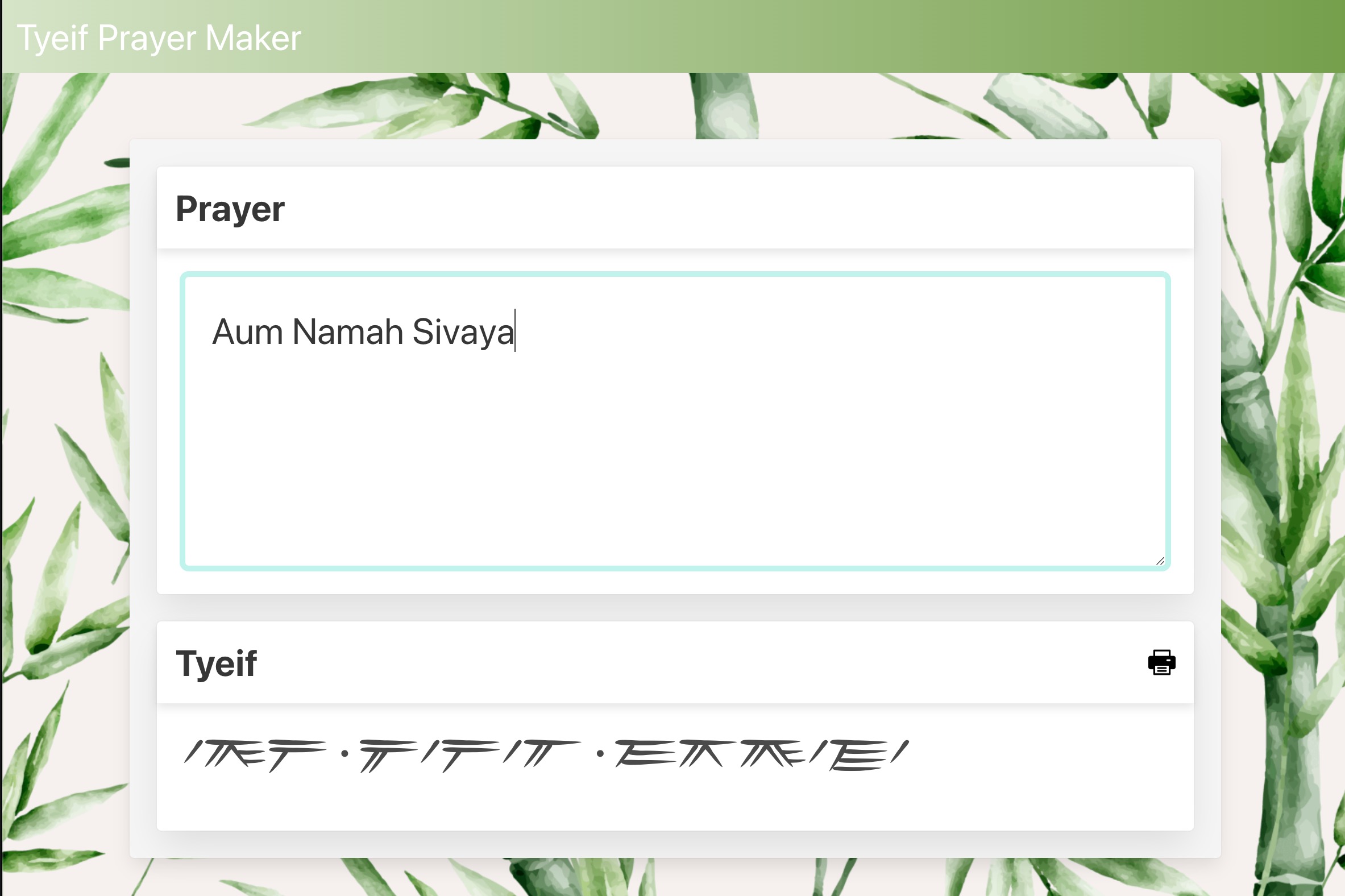A New Web App for Tyeif Script!
Aum Namah Shivaya
After reading an inspiring Master Course lesson, Mahesh Sundaram coded and produced this wonderful little app for transcribing English into the tyeif script for prayer writing to the Devas. Give it a try!
Lesson 321 – Living with Śiva
The Bamboo Tyēīf Font
Several years ago we created a Tyēīf font for the computer, to make it easy to write legible prayers in Tyēīf. It is good for your powers of concentration to learn to read the Tyēīf script, but if you are using a computer, this is not really necessary, unless you want to write Tyēīf by hand, which many do. The easiest way to compose your prayer on a computer is to type in an English font, such as Geneva, and then select the text and change it to the Tyēīf font. Prayers written in Tyēīf have built-in confidentiality. You might leave a prayer to the devas on your desk. As few people read the Tyēīf script readily, confidentiality is ensured. ¶Should you be traveling and not have your computer with you, you can always write your prayers in Tyēīf the old-fashioned way, by hand. It is artistic to use a soft flow pen, and even more artistic to use a Japanese ink brush. If you want to be really modern, use a black, sharp-pointed pen. The Tyēīf script looks good coming from whatever plume you choose. Many devotees enjoy writing Tyēīf by hand in vertical columns from top to bottom. When writing by hand, this is quite acceptable. Always use black ink, never colors. Black translates to white or gray in the inner world, where the prayer appears reversed. The paper that is white becomes black, and the letters that are black become white. It is only by two or three devas holding it and putting their prāṇas into it that the prayer again becomes black on white as it appeared when it was sent. They do this only when they want to keep the document to study it. Many prayers are so simple that they can be easily memorized as they appear on the black background in white ink, and it is not worthwhile energizing them into a durable form. ¶If you use colored paper and colored ink in writing your prayers, your words could be unreadable, even using the Tyēīf script. Colored paper appears dark purplish-blue in the inner world, somewhat like the ashes of burned paper, still intact, but barely legible, ready to disintegrate at the first touch. Therefore, just sit down and write your prayer in Tyēīf with a black pen on white paper. ¶Typed documents—on one side of the page only—are acceptable and easily read in the inner world, as long as the size of the type is not too small. Typewritten prayers (again, on one side of the page) in English or any language are also acceptable to the devas, as are hand-printed prayers that are written with well-rounded, clearly formed letters. Be sure to sign the prayer and also include the date. ¶The writing of prayers can be done in several ways. Each devotee can write his or her own prayer about personal questions, needs or problems. One can pray for another person, for a group of people, or for a situation to clear up within a group or community, even for solutions to national or world problems. Every prayer received is answered in some way, however mysterious. Not one is neglected, ever. ¶The Gods and devas look very carefully into the karma of the devotee before taking any action. Because of this, it is always best to describe two or more alternatives that you would be satisfied with in each prayer, rather than insisting on only one solution. This is because your first preference may not be possible in your karmic pattern or, without your knowing, it may actually be the worst possible thing that could happen to you. In this case, your prayer would be answered with a non-answer. Therefore, it is wise to suggest two or more alternatives when making a request. For example, in seeking help in finding employment, you might suggest three places you would be content at, indicating first choice, second and third.
7 Responses to “A New Web App for Tyeif Script!”
From Our Gurus' Teachings
Archives are now available through 2001. Light colored days have no posts. 1998-2001 coming later.


April 9th, 2023 at 1:06 am
It has been in my mind for the past eight months to seek a copy from our Monastery. The Script was mentioned in the monthly reports of the 90s’ on a few occasions. How may I get a copy of the script so that I may practice using a Japanese ink brush ! Many thanks to our Monastery and Mahesh Sundaram for allowing us this new masterpiece app. Aum Namasivaya.
April 9th, 2023 at 3:29 am
1000 thanks 🙏
April 9th, 2023 at 8:45 am
What a wonderful gift Mahesh! Very cool! What a great tool for learning Tyeif as well.
Om shanti . . .
April 9th, 2023 at 9:22 am
Many thanks Mr. Mahesh! 🙏🏼
April 9th, 2023 at 4:28 pm
“AUM”!.
April 9th, 2023 at 6:48 pm
Very practical and a friendly user app. Thank you. Aum.
March 6th, 2024 at 4:37 am
Thank you Mr. Mahesh.
Love this help.
Aum.